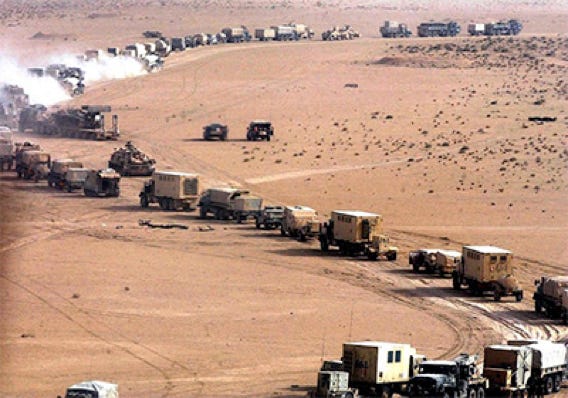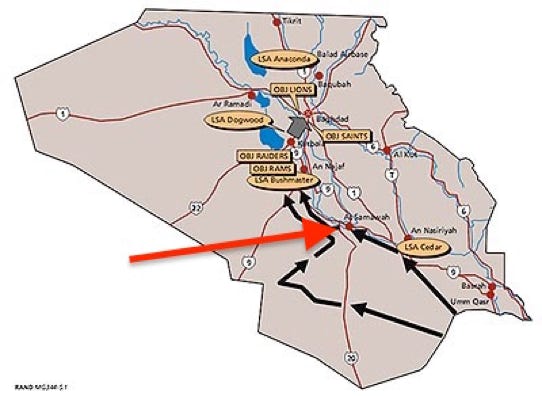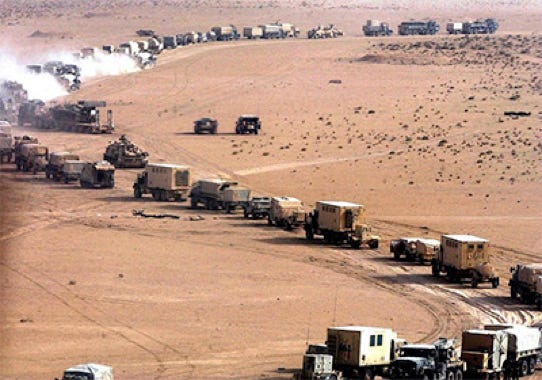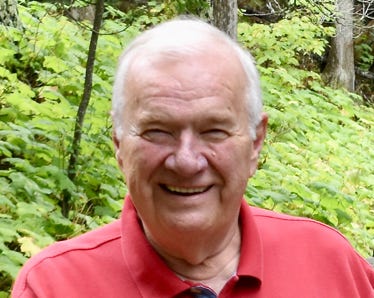Talking Proud: Service & Sacrifice
Logistics in the Iraq War: “A Herculean feat”
“Good generals study tactics. Great generals study logistics”
Battlefield Dynamism: As Samawah
“No plan survives contact with the enemy”
This matter of "battlefield dynamism" is interesting when considering logistics support. You’ve already been exposed to some of it. Events on the battlefield never go exactly as expected; sometimes, they don’t even go as remotely expected. As a result, once combat operations got underway, units were shifted around to meet battlefield needs, which affected how they would be supported.
I mentioned Lt. Don Gomez earlier, a rifle platoon leader with the 82nd Airborne Division.
Gomez said his unit had been trained to parachute into an urban environment. Later, they were trained to parachute into Baghdad airport and seize it, a different kind of mission.
He and his men were sitting in Kuwait, ready to airdrop into the airport, when the order came to clear As Samawah, a completely different mission.
The 3rd ID contacted enemy forces in the As Samawah area, southwest of the Karbala Gap. With the help of air and artillery, the 3rd destroyed much of that force and kept on trucking, bypassing the town, though this fight temporarily delayed its progress.
As Samawah was important because it was between the 3rd ID and the Karbala Gap. The 3rd ID had to pass through the Gap to reach Baghdad, and once it passed, As Samawah would be to its rear.
Parachuting into the Baghdad airport was now off the table. Gomez’s men had to go to As Samawah and clear it of enemy. His brigade boarded C-130s, but Gomez was annoyed that he was not wearing his parachute. He was not wearing it because the C-130s would land at Tallil AB, which had been captured. Upon landing, the men took defensive positions around the airfield.
They were then told to board a group of trucks that had arrived a little earlier. Gomez said they were “old Army trucks that I had never seen before.” He said they were utility trucks, uncovered, not combat vehicles. Apparently, the brigade men would have to drive the trucks themselves in what was sarcastically called a "Ground Assault Convoy," an outrage for airborne forces trained to conduct airborne assaults!
Gomez commented while sitting in the old truck:
“As we crept towards the exit of the (Tallil) airfield (headed for As Samawah), I looked out at an endless sea of military equipment. There were trucks, tanks, artillery, armored personnel carriers, helicopters, and steel containers for as far as I could see … The enormity of what we were doing started to hit me. We were only days into the war, and all of this equipment was here, ready to be switched to kill.”
The airfield was only captured on March 22. Logistics convoys from the south apparently arrived shortly after March 22, unloading equipment and supplies, and already there was "an endless sea of military equipment" at the field.
As events turned out, the 82nd ABN had been held in Kuwait for just this kind of mission. The Iraqis knew the 3rd ID was coming and where it was headed, so they embedded multiple militias, including the Fedayeen Saddam paramilitary, inside the city of As Samawah. Iraq also assembled regular forces there to attack the 3rd ID to slow it down. It would be especially useful to the enemy to lure the 3rd ID force into the city for an urban fight, but that did not happen.
The Fedayeen inside the town were tasked to attack the 3rd ID’s rear should it get by, which it did, and also attack any logistics forces in trail formation along this major supply route. The 82nd’s job was to deal with these Iraqi forces and keep the US combat forces and logistics train moving.
Lt. Gomez said:
“We didn’t get a very good mission brief, other than we were going to walk into As Samawah and try to start a fight. The plan was to just walk, one behind the other, straight into the city until something happens. We were confused and pissed. This was the exact opposite of what we had trained. We expected to attack deliberate targets, moving in tactical formations under the cover of darkness, using our night vision devices to our advantage, utilizing principles of fire and maneuver to maximize our combat power. Our complaints were heard, noted, and discarded. We slid our armor over our shoulders, hoisted up our bags of explosives, and moved out towards As Samawah. One foot in front of the other.”
They were trucked from Tallil to As Samawah, I calculate a 50 mile trip, and all hands were there by March 28.
They did meet the enemy, and some fierce battles raged. During one of these, Gomez said, “The platoon opened up with their machine guns. Then everyone started shooting. Gunfire and explosions everywhere.”
The men were notified that a Bradley Infantry Fighting Vehicle (BIFV) from the 3rd ID was on its way to provide support. Gomez commented, “Ten minutes … 30 minutes... an hour... four hours.” It did not get there until the next morning. This gave new meaning to “the Bradley is on its way!”
The fighting had stopped, and the men caught some sleep. When they woke up, they were told to move out. Once done, they were engaged again by enemy forces. Gomez said,
“Once we started shooting, everyone started shooting. A volley of death into nothing. We fired for a minute or so, a tiny explosion of hate and fear in the middle of Iraq.”
Fortunately for him and his colleagues, they maneuvered into a house, where an Iraqi lady was baking bread—“lots of it,” he said.
Gomez continued,
“Pieces of bread were passed around. They were fresh and warm. The exterior was either soft or crusty, but the inside was always doughy. There was more than enough. The women kept cooking until we stopped eating. Soldiers held giant pieces of circular bread and pulled off small pieces, filling their cheeks.”
Later on, the family brought them tea and sweets.
Obviously, this group bumped into a kind family, which underscores why the American rules of engagement are so stringent regarding civilians.
The 82nd's force focused next on a cement factory and ended up in some serious firefights: small arms, mortar, RPGs, and snipers. OH-58D Kiowa Warrior helicopters, Navy F/A Hornet jet fighters, A-10 Warthogs, AC-130 gunships, and 105 mm howitzers all came raining down on the enemy, along with return fire from the men on the ground. It took forces from the 82nd Airborne, the 1-41st Infantry, and the 2-70th Armor to win the day, but it also took until April 4 to get that done.
This fighting, involving Lt. Gomez and the others, took a lot of time, from March 28 through April 4. It explains why the 82nd received the orders it received. While its men were fighting the enemy in As Samawah, the 3rd ID kept moving north, and its supply lines remained open. Battlefield Dynamism at work.
Click to zoom graphic-photo






